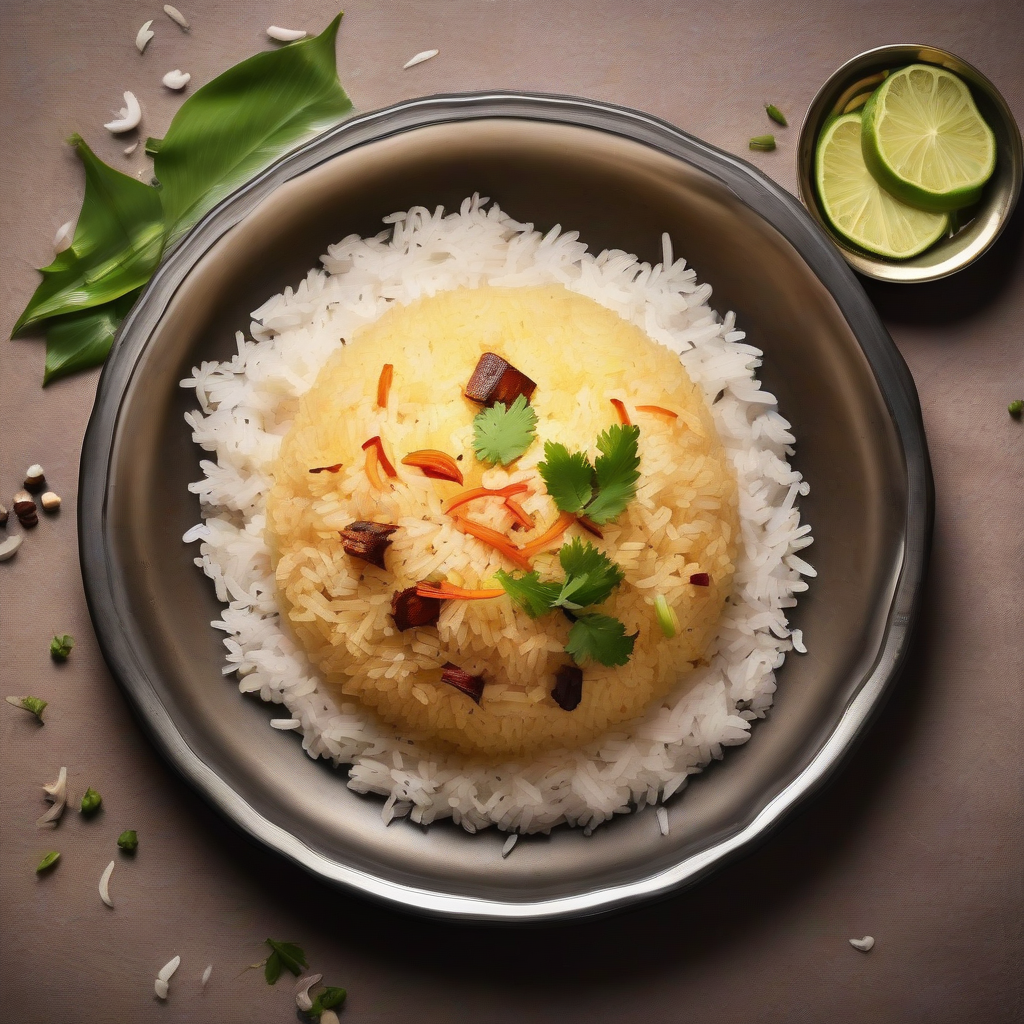Aye Hai! Nariyal Chawal Fry: Your Next Favourite Comfort Food!
Namaste, Salaam, and Sat Sri Akal, my food-loving friends! Chef Curry Do’pyaza here, ready to spice up your life with a dish that’s as comforting as a warm hug on a chilly day. Today, we’re diving into the delightful world of Nariyal Chawal Fry, or as you might know it, Coconut Rice Fry!
This dish is a staple in many South Indian homes, particularly in Tamil Nadu, Kerala, and Karnataka. It’s a dish that sings of sunshine and coastal breezes. You’ll often find it gracing the tables during festive occasions like Pongal, Onam, and Ugadi. It’s also a popular dish during temple festivals and family gatherings, where the aroma of coconut and spices fills the air. It’s truly a dish for celebrations!
A Little Trip Down Memory Lane
While tracing the exact origin of Nariyal Chawal Fry is tricky, it’s safe to say it’s been around for generations. Coconut, a readily available ingredient in coastal India, has always been a star in South Indian cuisine. This dish likely evolved as a way to use leftover rice, transforming it into something new and delicious. It’s a testament to the resourcefulness and culinary genius of Indian home cooks!
Let’s Get Cooking!
Preparation Time: 15 minutes
Cooking Time: 20 minutes
Ingredients – The Magic Makers:
- Chawal (Rice): 2 cups, cooked and cooled (day-old rice works best!)
- Nariyal (Coconut): 1 cup, freshly grated (desiccated coconut works too, if you’re in a pinch!)
- Pyaaz (Onion): 1 medium, finely chopped
- Hari Mirch (Green Chillies): 2-3, finely chopped (adjust to your spice preference)
- Adrak-Lahsun Paste (Ginger-Garlic Paste): 1 teaspoon
- Rai (Mustard Seeds): 1 teaspoon
- Urad Dal (Split Black Gram): 1 teaspoon
- Chana Dal (Split Chickpea Lentil): 1 teaspoon
- Kari Patta (Curry Leaves): 1 sprig, roughly chopped
- Haldi Powder (Turmeric Powder): ½ teaspoon
- Hing (Asafoetida): A pinch (optional, but adds a lovely flavour)
- Tel (Oil): 2 tablespoons (coconut oil is ideal for that authentic flavour)
- Namak (Salt): To taste
- Hara Dhaniya (Fresh Coriander): 2 tablespoons, chopped (for garnish)
- Nimbu (Lime): 1/2 (for a tangy twist)
Step-by-Step Instructions – Your Culinary Journey:
- Heat the Oil: In a kadhai (wok) or a large pan, heat the oil over medium heat. The oil should shimmer, ready to welcome our spices.
- Tempering Time: Add the mustard seeds. Once they start to splutter, add the urad dal and chana dal. Fry until they turn golden brown, releasing their nutty aroma.
- Aromatic Infusion: Add the asafoetida (if using), chopped onions, and green chillies. Sauté until the onions turn translucent and slightly golden.
- Ginger-Garlic Magic: Add the ginger-garlic paste and sauté for another minute, until the raw smell disappears.
- Spice it Up: Add the turmeric powder and curry leaves. Sauté for a few seconds, allowing the spices to bloom and fill your kitchen with their fragrant essence.
- Coconutty Goodness: Add the grated coconut and sauté for 2-3 minutes, until it turns light golden brown. Be careful not to burn it!
- Rice Integration: Add the cooked rice and salt to taste. Gently mix everything together, ensuring the rice is well coated with the coconut and spices.
- Simmer and Savor: Reduce the heat to low and cover the pan. Let it simmer for 5-7 minutes, allowing the flavors to meld together beautifully.
- Garnish and Serve: Garnish with fresh coriander leaves and a squeeze of lime juice. Serve hot and enjoy!
Tips for Best Results – Chef’s Secrets:
- Rice Matters: Using day-old rice is crucial. Freshly cooked rice tends to get mushy.
- Coconut Freshness: Freshly grated coconut gives the best flavour, but desiccated coconut works in a pinch. Just soak it in a little warm water for a few minutes before adding it to the pan.
- Spice Level: Adjust the number of green chillies to your liking.
- Don’t Overcook: Be careful not to overcook the coconut, as it can become bitter.
Cooking Variations – Your Kitchen, Your Rules:
- Gas Stove: Follow the instructions above for the classic method.
- Induction Stove: The same instructions apply, just be mindful of the temperature settings.
- Pressure Cooker: Not recommended for this recipe, as the rice can become mushy.
- Oven: You can bake the rice in a preheated oven at 350°F (175°C) for about 15-20 minutes, but the texture will be different.
- Microwave: You can reheat leftover Nariyal Chawal Fry in the microwave.
- Air Fryer: Not suitable for this recipe.
- Slow Cooker/Crockpot: Not recommended, as the rice will likely become overcooked.
Nutritional Information (Approximate per serving):
- Calories: 250-300
- Protein: 5-7g
- Fat: 10-15g
- Carbohydrates: 35-40g
Serving Suggestions – Make it a Feast!
- Serve Nariyal Chawal Fry as a side dish with your favorite South Indian curries like sambar or rasam.
- Enjoy it as a light lunch or dinner with a side of raita (yogurt dip).
- Pack it in your lunchbox for a delicious and satisfying meal.
Your Turn!
Now that you have the recipe, it’s time to unleash your inner chef! Try this simple yet flavorful Nariyal Chawal Fry at home. Share it with your friends and family, and let them experience the magic of Indian cuisine. Happy cooking!
